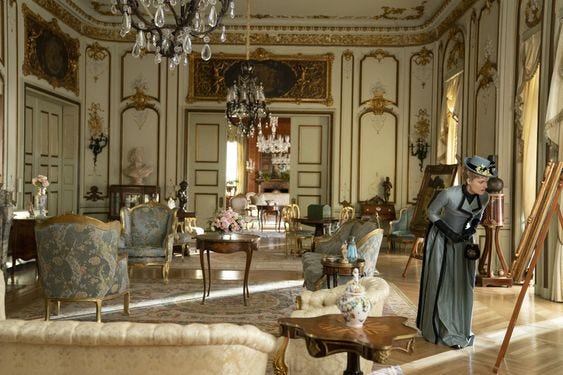
As you’re reading this, I may just be touring an duomo or ogling a rainbow of gelato. I am thrilled to be back in one of my favorite spots in the world, but whether in Italy or at home, I am paying attention to abundance this fall.
Earlier this year, after a binge-watching revelry focused on over-the-top costume dramas (Bridgerton and The Gilded Age), I realized how compelling I find the “muchness” of it all - intricately reconstructed historical settings alongside furnishings, fabrics, and frills to die for. I’m all in for delicious lavishness.
Sure, tales of wealth, royalty, or glamour allow a peek into worlds we can never expect to inhabit. Downton Abbey (RIP Dame Maggie!), The Crown, The Great, Palm Royale, The Marvelous Mrs. Maisel, White Lotus, and Succession load up on style and settings that you won’t see everyday. But more than that, they evoke times and places with an incredible richness of detail. And my observing, sensing brain eats it up.
More costumes, more intrigue, more character flourishes = more captivating intensity. More color, more flavor, more variety = magical Abundance.
We recognize a depth of care when the gelato maker provides a wealth of choice, or the cinematographer establishes authenticity by layering props and costumes with color and pattern. Either way, it’s a treat to find oneself on the receiving end of such abundance.
And it’s human nature to be drawn to detail.
CANVAS magazine calls devotion to the minutiae of artistic craft a “labor of love and in service of truth.” It takes patience and resolve to focus on the fine points that makes art accessible to viewers, listeners, or readers at all levels. In a random painting, I might pick up on the repetition of reds, while you appreciate fine brushstrokes or widely varying facial expressions. In another kind of work, we might dig into resonant words or sounds. We connect differently, and lots of detail offers openings to everyone.
When details mount up, little treasures of expression or description catch our eyes, inspiring wonder. Attention to the tiniest parts encourage us to enter into artistic creations as a whole. The deep Noticing of those who create fuels our own imagination, and transports us to times or places that feel truthful, even when they’re fantastical.
And then, there’s Your Brain on Fiction. According to neuroscientists, stories impact our brains, stimulating and changing them.
Recently, Melissa Kirsch, deputy editor of Culture and Lifestyle in the New York Times wondered “if a book still counted if I couldn’t remember much about it,” the scientists and authors she consulted concurred: We have capacity for an abundance. The art, stories, emotions, descriptions, and experiences in your brain are “in some way working on you even though you aren’t thinking about it.”
Whether in books or on screens, in museums or galleries, at the theater, concert hall, table or in a cone, rich details captivate us. We don’t even have to remember them. It’s enough to spend time in the experience.
Personally, amidst a lot of travel, I need to remind myself to slow down and read the world around me in all of its particularity. To that end, I’m spending time away from my computer watching, listening and taking in the details. Along the way, I’m digging into some old and new favorite children’s books, relishing the things that spark notice.
I’ve been especially riveted by the works of a handful of author-illustrators who invite us to experience abundance by looking deeply:
The Fan Brothers (Eric and Terry Fan) - Check out The Night Gardener (2016) or Ocean Meets Sky (2018) for imaginative worlds with a little steampunkish flair.
Richard Scarry - My all time favorite is What do People Do All Day (1968) but any of his books for preschoolers are packed with humorous detail.
Dr. Suess - The Cat in the Hat (1957) Oh! The Places You’ll Go (1990) and anything involving Whoville sends up vivid color, extra expressive settings, characters, and action.
Maurice Sendak - Caldecott winner Where the Wild Things Are (1963) and E.T.A. Hoffman’s Nutcracker (1984) simply create worlds worth visiting.
Sophie Blackall - Farmhouse (2022) and the Caldecott winning Lighthouse (2018) feel like incredibly layered patchworks of texture and atmosphere.
Do you know others worth poring over?
What stories, illustrated or not, convey abundance to you?
Wherever you are this fall, keep an eye out for generous detail - intensity, specificity, or imaginative muchness. Perhaps you’ll find it in a Wes Anderson film, a painting, your to-be-read stack, the natural world, or the potential in your library. Revel in the moments. Immerse yourself in abundance. It’s good for you.






I'm normally drawn towards simplicity in design, but you do make a good point for abundance here. It's wonderful to look at something that's layered enough to notice new things each time. As a kid I loved Graeme Base books for their abundant detail.